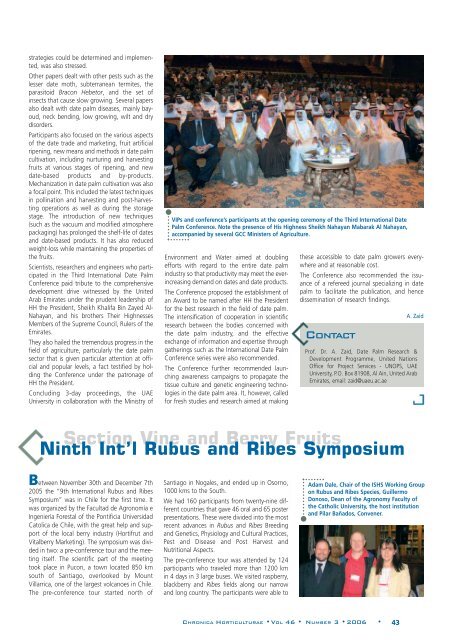Acta Horticulturae
Acta Horticulturae
Acta Horticulturae
You also want an ePaper? Increase the reach of your titles
YUMPU automatically turns print PDFs into web optimized ePapers that Google loves.
strategies could be determined and implemented,<br />
was also stressed.<br />
Other papers dealt with other pests such as the<br />
lesser date moth, subterranean termites, the<br />
parasitoid Bracon Hebetor, and the set of<br />
insects that cause slow growing. Several papers<br />
also dealt with date palm diseases, mainly bayoud,<br />
neck bending, low growing, wilt and dry<br />
disorders.<br />
Participants also focused on the various aspects<br />
of the date trade and marketing, fruit artificial<br />
ripening, new means and methods in date palm<br />
cultivation, including nurturing and harvesting<br />
fruits at various stages of ripening, and new<br />
date-based products and by-products.<br />
Mechanization in date palm cultivation was also<br />
a focal point. This included the latest techniques<br />
in pollination and harvesting and post-harvesting<br />
operations as well as during the storage<br />
stage. The introduction of new techniques<br />
(such as the vacuum and modified atmosphere<br />
packaging) has prolonged the shelf-life of dates<br />
and date-based products. It has also reduced<br />
weight-loss while maintaining the properties of<br />
the fruits.<br />
Scientists, researchers and engineers who participated<br />
in the Third International Date Palm<br />
Conference paid tribute to the comprehensive<br />
development drive witnessed by the United<br />
Arab Emirates under the prudent leadership of<br />
HH the President, Sheikh Khalifa Bin Zayed Al-<br />
Nahayan, and his brothers Their Highnesses<br />
Members of the Supreme Council, Rulers of the<br />
Emirates.<br />
They also hailed the tremendous progress in the<br />
field of agriculture, particularly the date palm<br />
sector that is given particular attention at official<br />
and popular levels, a fact testified by holding<br />
the Conference under the patronage of<br />
HH the President.<br />
Concluding 3-day proceedings, the UAE<br />
University in collaboration with the Ministry of<br />
VIPs and conference’s participants at the opening ceremony of the Third International Date<br />
Palm Conference. Note the presence of His Highness Sheikh Nahayan Mabarak Al Nahayan,<br />
accompanied by several GCC Ministers of Agriculture.<br />
Environment and Water aimed at doubling<br />
efforts with regard to the entire date palm<br />
industry so that productivity may meet the everincreasing<br />
demand on dates and date products.<br />
The Conference proposed the establishment of<br />
an Award to be named after HH the President<br />
for the best research in the field of date palm.<br />
The intensification of cooperation in scientific<br />
research between the bodies concerned with<br />
the date palm industry, and the effective<br />
exchange of information and expertise through<br />
gatherings such as the International Date Palm<br />
Conference series were also recommended.<br />
The Conference further recommended launching<br />
awareness campaigns to propagate the<br />
tissue culture and genetic engineering technologies<br />
in the date palm area. It, however, called<br />
for fresh studies and research aimed at making<br />
these accessible to date palm growers everywhere<br />
and at reasonable cost.<br />
The Conference also recommended the issuance<br />
of a refereed journal specializing in date<br />
palm to facilitate the publication, and hence<br />
dissemination of research findings.<br />
CONTACT<br />
A. Zaid<br />
Prof. Dr. A. Zaid, Date Palm Research &<br />
Development Programme, United Nations<br />
Office for Project Services - UNOPS, UAE<br />
University, P.O. Box 81908, Al Ain, United Arab<br />
Emirates, email: zaid@uaeu.ac.ae<br />
Section Vine and Berry Fruits<br />
Ninth Int’l Rubus and Ribes Symposium<br />
Between November 30th and December 7th<br />
2005 the “9th International Rubus and Ribes<br />
Symposium” was in Chile for the first time. It<br />
was organized by the Facultad de Agronomía e<br />
Ingeniería Forestal of the Pontificia Universidad<br />
Catolica de Chile, with the great help and support<br />
of the local berry industry (Hortifrut and<br />
Vitalberry Marketing). The symposium was divided<br />
in two: a pre-conference tour and the meeting<br />
itself. The scientific part of the meeting<br />
took place in Pucon, a town located 850 km<br />
south of Santiago, overlooked by Mount<br />
Villarrica, one of the largest volcanoes in Chile.<br />
The pre-conference tour started north of<br />
Santiago in Nogales, and ended up in Osorno,<br />
1000 kms to the South.<br />
We had 160 participants from twenty-nine different<br />
countries that gave 46 oral and 65 poster<br />
presentations. These were divided into the most<br />
recent advances in Rubus and Ribes Breeding<br />
and Genetics, Physiology and Cultural Practices,<br />
Pest and Disease and Post Harvest and<br />
Nutritional Aspects.<br />
The pre-conference tour was attended by 124<br />
participants who traveled more than 1200 km<br />
in 4 days in 3 large buses. We visited raspberry,<br />
blackberry and Ribes fields along our narrow<br />
and long country. The participants were able to<br />
Adam Dale, Chair of the ISHS Working Group<br />
on Rubus and Ribes Species, Guillermo<br />
Donoso, Dean of the Agronomy Faculty of<br />
the Catholic University, the host institution<br />
and Pilar Bañados, Convener.<br />
CHRONICA HORTICULTURAE •VOL 46 • NUMBER 3 • 2006 • 43
















